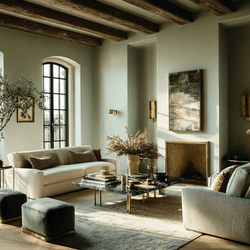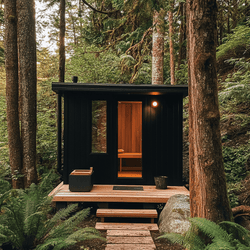Why Full Spectrum Color is Changing the Paint Game
Brilliant Color and Better Coverage
Have you ever heard someone toss around the term “full-spectrum paint” and wondered what they were talking about? Well, it’s not just for insiders anymore. Most of us are looking for paint color that will be beautiful, dynamic and durable. Enter, full spectrum paint.
Quite simply, full spectrum paint color utilizes multiple pigments that represent more of the color wheel. Most paint colors are made with two or three pigments, plus black, to create the majority of paint colors on the market. Full spectrum paints often have upwards of eight or more pigments, and no black, to create more beautiful, luminous colors.
C2 Paint’s “Zorro”, a near black color that feels as mysterious as the masked man himself, contains no black pigment. Black paint made with no black? It sounds crazy, but it’s true! So, why does that matter to you?
Historically, black has been an important pigment in the paint industry because it gives paint makers a shortcut to getting great coverage in one or two coats. If you have ever had the chore of painting four or five coats of red on a wall, then you know what I mean.
There is a huge drawback to using black in the production of paint colors. Black pigments “de-chromatize” colors and make them look lifeless at certain times of the day. That means that the rich claret color you so painstakingly chose will look grayed and dull instead of colorful and interesting. Think about it in scientific terms: black absorbs light, rather than reflects it. Make sense?
Since no one wants muddy, lifeless walls, the solution is to use a full spectrum approach to creating every color. Once I explain how C2 Paint colors are made, I am often asked by my customers: “Why doesn’t every paint company do this; it seems so logical?”
Top 3 Reasons Why Companies Don’t Invest in Full Spectrum Paint Color:
#1 The basic pigment cost is higher, and most paint companies are interested in shaving those dollars OFF their costs, not adding to them. Investing in better pigments and investing in new color recipes for an entire paint brand is not seen as a priority to those shareholders. I certainly don’t blame them; the cost is immense to make changes across a national platform, but it DOES affect how the paint interacts with light, and ultimately it affects how I feel about the color!
#2 Most paint makers don’t consider color in their decisions. (I know, it makes no sense!) And if they do, it’s pretty much last in the equation. First, the price points of the paint are determined, and then the paint itself is formulated. The color conversation is secondary to all of this.
#3 Lack of interest in color. This sounds pretty fundamental, but I think there is a lot of truth to this idea. Paint chemists are not by nature colorists. So, it’s simply not on their radar in the same way as it is to you and me.
When you or I get ready to repaint, our primary concern is about the color. We know that when we go to our independent paint store, they represent great-quality products. But how that color will look on the wall year after year has to be taken into consideration.
At C2, paint color is as much a primary value to the company as is the paint product itself.

The Proof is in the Pigments
Are you aware that different paint companies use different pigments to make their colors? That’s why you can’t just take a paint recipe from one company and have it made into someone else’s paint brand. They don’t necessarily translate without some serious color-matching skills.
Some pigments are finely ground and are made of very small particles; others are larger and less uniform in size and shape. The smaller ones cost more than the larger ones, which is one reason why cheap paint never looks like it does on the sample. This particle size also affects how the color displays on your wall.
Paint, by its very nature, is transparent. Yes, you can actually see through it! That’s why it takes four or five coats of “average” paint to get adequate coverage on certain colors, like reds. When you use a finer grind of pigment to make a color, you end up with a paint that also gives much a better, more opaque, coverage or “hide.”
It’s similar to the difference between using cheap, drugstore eye shadow and higher-quality department store eye shadow. The color, application, longevity and final product are that much better with the good stuff.
With better hide, our old friend black is no longer needed in the equation. And with black out of the picture, we can make our walls feel luminously beautiful. Not bad for a can of paint!











